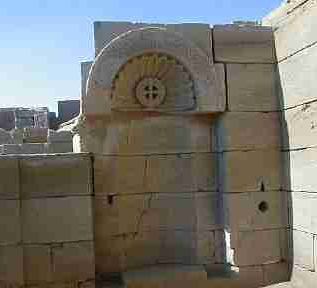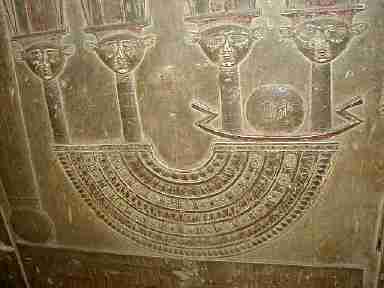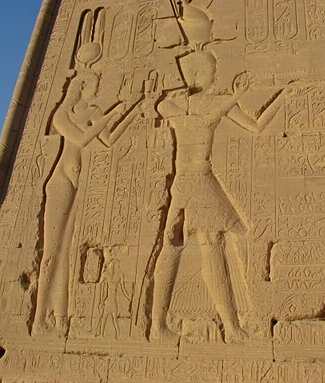Dendera: Temple of Hathor
The temple standing today was begun during the Ptolemaic period (ca. 320-330 BCE) but the Romans added their bit until it was completed during the time of the Emperor Tiberius (14-37 CE). Its history, however, goes much further back -- some foundations remain that date to the time of Khufu (he of the pyramid) in the 4th Dynasty.
| Hathor, to whom the temple is dedicated, was a very ancient and revered fertility goddess who was, furthermore, the daughter of the primordial goddess, Nut, with whom she was sometimes identified. We will see signs of that identification when we enter the temple.
The temple compound is enclosed in a mud brick wall parts of which, suitably reinforced, remain standing. | 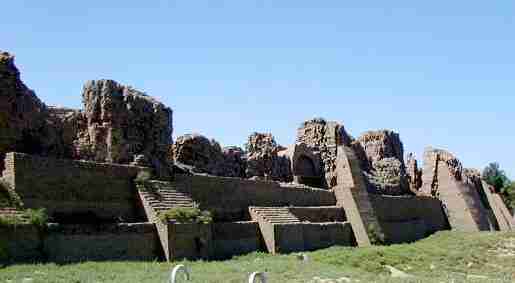 |
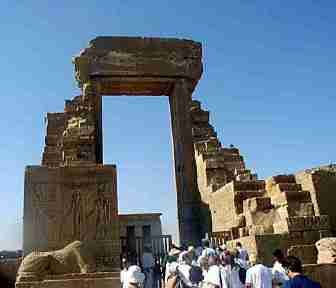 | Entrance is by the north gate where, by a quick glance upward, one may spy colorful decoration hinting at the splendor that once was.
 |
Past the gate and to one's right are two "birth houses" (mammisi) in which was celebrated the birth of Ihy, the son of Horus and Hathor. The one containing the relief below was begun by the Roman Emperor Nero and completed by Trajan, Hadrian, and Hadrain's lover, Antoninus. The decoration depicts Hathor, wearing her distinctive headdress of cow horns with the solar disk between, nursing her son, Ihy, who is depicted, not as an infant but as a small man.
The unpleasant little fellow with the rosy cheeks beside them is Bes, the protector of women and children at childbirth. He is ugly and fearsome in order to frighten away spirits more evil than he appears to be himself. The figure is in the courtyard outside the birth house.
Next to the "birth house" are the ruins of a fifth-century CE Coptic church with these clearly Christian decorations. But the crosses are not the only testimony to the Christian presence. The Copts, who spoke a variant of the ancient Egyptian language and wrote it with Greek letters, were literally afraid of the religious figures of their predecessors so they defaced them to deprive them of their power.
The hypostyle hall of Hathor's Temple contains twenty-four Hathor-headed columns, of which the first six form its façade. The huge size of the structure may be gauged by noticing the human figures standing at the entrance.
| The ceiling of the hypostyle hall is decorated with an elaborate depict- ion of the sky, as well as the hours and months. At the ends of the hall Nut gives birth to the sun and Hathor emerges from the sun's rays. The motif is found also in the "Chapel of Sanctity" (right). | 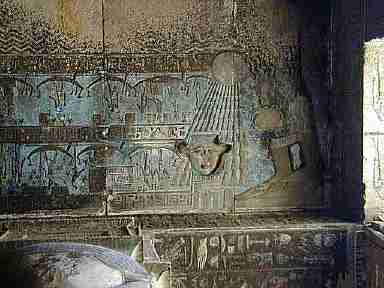 | 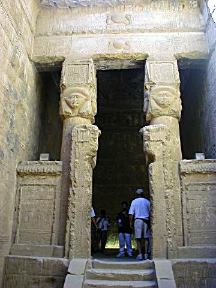 |
We saw that Amun and his family traveled from Karnak to Luxor and back for the annual Opet festival. Just so Hathor traveled from Dendera to Edfu in order to meet Horus. The consequence of their annual meeting was the birth of Ihy. There is no surprise, therefore, to find Horus (as a falcon) depicted at Dendera, along with the many images of Hathor.
 | The final periods in ancient Egyptian history -- when native Egyptian rulers were no more and those who styled themselves "pharaohs" were Greeks and Romans -- were filled with political and social uncertainty. Nothing in the archeological record reveals that instability more vividly than the empty cartouches -- merely ovals with no names inside -- found at Dendera temple. The artists were prepared for whomever became king but weren't certain who that was, or was to be, so they left the cartouches blank. As it turned out, no one ever filled them in. |
Since Dendera, in its preserved form, is no older than the fourth century BCE the roof of the hypostyle hall not only is intact but so are small shrines to Isis and Hathor resting upon it. The wall of a stairway leading upward shows a ceremonial procession such as often must have climbed from the darkness of the temple toward the full rays of the ever-present Egyptian sun on the roof.
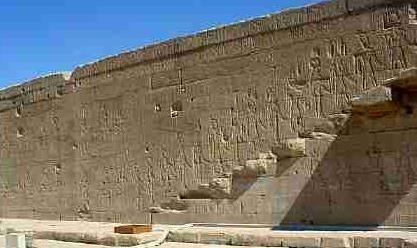 | And here, on a wall on the roof of Hathor's temple, is the "cartouche" of our friend, John Gordon, whom we last met at Karnak temple.

|
| The view from the roof of the hypostyle hall provides a visual guide to the buildings seen upon entrance to the complex. The entrance gate (the one with the colorful decoration on it's underside) set in the Roman mud-brick wall, is at the extreme right. Next comes the Roman era (Nero, Trajan and company) "birth house," then the ruins of the Coptic church. In the foreground are the ruins of an earlier "birth house" associated with Nectanebo I (380-362 BCE).
|  |



